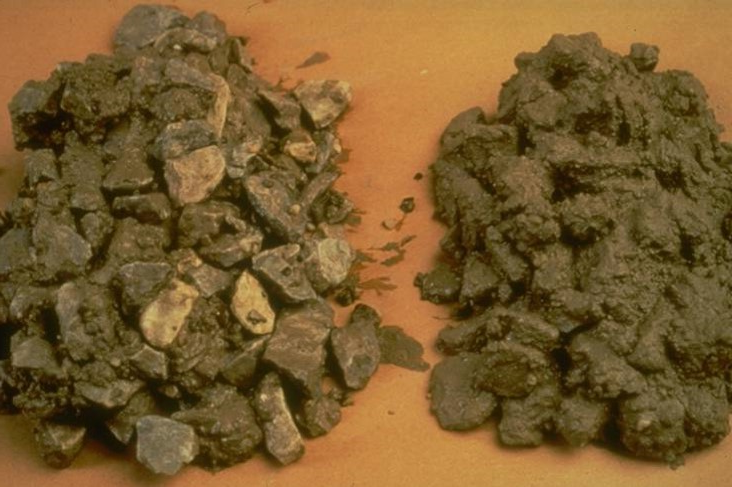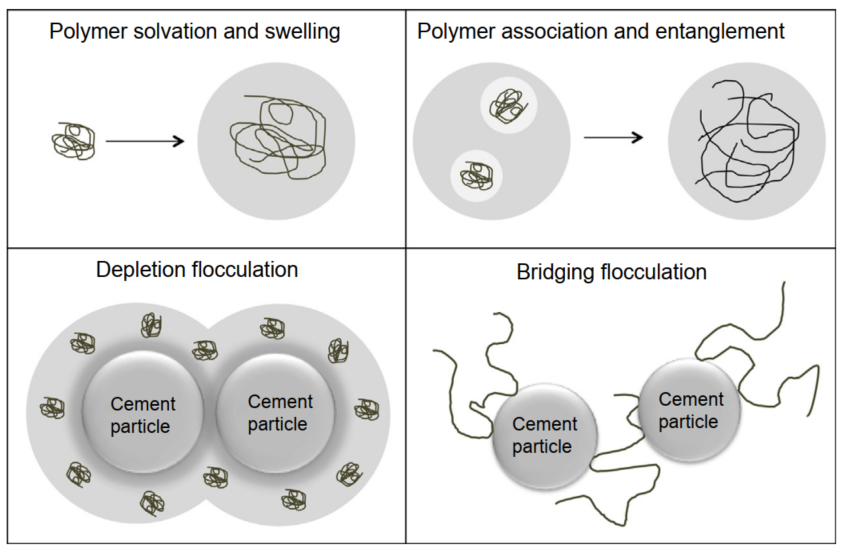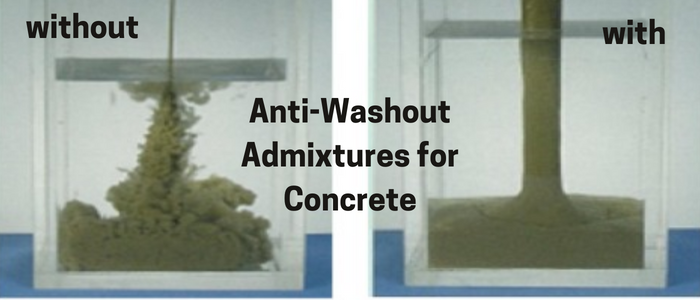When we speak of underwater concreting, we will have to mention the anti-washout admixtures. A short note here is that underwater concreting refers to the casting and placement of fresh concrete under water. Not just the underwater concrete uses the anti-washout admixtures. These admixtures are also implemented in self-compacting concrete, shotcrete, and grouts.
In this article, we explore the mechanism of anti-washout admixtures, types of anti-washout admixtures and what are the benefits and limitations of using them.
Anti-Washout Admixtures
Anti-washout admixtures are sometimes called water-retaining or viscosity-modifying admixtures. These admixtures increase the stability, cohesion and robustness of concrete. The application of underwater concreting require highly fluid mixes to enable pouring but at the same time segregation and bleeding must be avoided.
So, yes superplasticizers are used in underwater concrete to give the high flowability but the anti-washout admixtures are the ones that provide the stability of concrete.

Dosage of Anti-Washout Admixtures
According to the needed flowability, the depth of the underwater placement, the horizontal flow distance, the water to cementitious materials ratio, and the amount of cementitious materials to be used, the amount of anti-washout additive that must be added to the concrete mixture is specified.
Mechanism of Anti-Washout Admixtures
Anti-washout admixtures increase the stability of cementitious systems due to a combination of different physico-chemical phenomena that depend on the nature of the anti-washout admixture and its concentration.
Polymeric anti-washout admixtures are highly hydrophilic and have high capacity to bind water molecules, increasing their effective volume in solution. This leads to an increase of the dynamic viscosity of the interstitial solutionand to an increase of the macroscopic viscosity of the cement suspension.
In addition, depending on the nature and concentration of the polymer, the following mechanisms can occur:

Bridging flocculation includes the binding of two or more cement particles by the adsorption of a chain of a high-molecular-weight polymer onto those particles. Increased cement suspension yield stress is a part of this process.
Polymer-polymer association: Segments having a tendency to interact with one another are dispersed along the chain of associative polymers. A 3D network is created as a result, increasing the viscosity of the interstitial solution, and intramolecular and intermolecular interactions between the polymer chains may also form.
Entanglement: At high concentrations, the chains of anti-washout admixtures polymers can entangle and increase the apparent viscosity of the interstitial solution and cement suspension.
Depletion flocculation happens as a result of the depletion of nonadsorbed polymers from a volume exclusion shell surrounding bigger particles. The system’s osmotic pressure rises as a result of the system’s flocculation due to the difference in polymer concentration between the bulk solution and the depleted zone. This technique increases the yield stress but does not change the plastic viscosity of the suspensions.
Types of Anti-Washout Admixtures
There are multiple classifications for anti-washout admixtures such. One classification is
- Natural polymers such as Starch, Welan gum, Diutan gum, Guar gum, Xanthan gum, Alginates
Agar. - Semi-synthetic polymers such as Cellulose-ether derivatives, Guar gum derivatives, Modified starch, Alginates derivatives.
- Synthetic polymers such as Polyethylene oxide and Polyvinyl alcohol.
Here, we categorize anti-washout admixtures into 5 types:
Class/Group A
This type includes the natural organic materials and synthetic water soluble materials that increase the viscosity.
Examples are: starch, cellulose ether derivatives, polyacrylamides, polyethylene oxides and polyvinyl alcohol.
Usually, the dosage of Type A admixtures falls in the range between 0.25% and 0.5% by mass of cement.
Class/Group B
This type includes the organic flocculants that adsorbs on the the cement particles. This type then increases the attraction forces between the cement particles and accordingly, increase viscosity.
Examples are: natural gums (welan, diutan, etc), styrene copolymers with carboxyl groups, and synthetic polyelectrolytes.
Usually, the dosage of Type B admixtures falls in the range between 0.01% and 0.1% by mass of cement.
Class/Group C
This type is a mix of different organic materials. In addition to the better attraction between cement particles, this type provides extremely fine particles in the cement paste.
Examples are: acrylic emulsions and paraffin-wax emulsions.
Class/Group D
This type includes inorganic materials that possess large surface area. They raise the capacity of concrete mix to keep and retain water.
Examples are: bentonites, pyrogenic silicas, and silica fume.
Class/Group E
This type includes inorganic materials add extra fine particles to the mortar pastes .
Examples are: fly ash, hydrated lime, and kaolin.
Precautions when Dealing with Anti-Washout Admixtures
When anti-washout admixtures are incorporated into concrete mixture, there are a number of practical factors that must be taken into account.
The volume of concrete mixture that must be handled and the mixer’s capacity may be the most important factors to take into account. This is due to the anti-washout additive significantly increasing the viscosity of fresh concrete, which raises the load of fresh concrete by 25 to 50%.
To reduce the water demand of concrete mixture, which is enhanced by the addition of anti-washout admixture, and hence preserve flowability, high range superplasticizers is frequently applied in combination with anti-washout admixture.
Another factor that must be taken into account is the pump’s capacity. On the one hand, if problems are found inside the pressure transmission tube during the pumping pressure period, high dispersion resistance blockage may develop in pump lines.
However, the pressure transmission resistance is enhanced by 2 to 4 times more than with traditional concrete due to the high viscosity of the concrete mixture.
Benefits of Using Anti-Washout Admixtures
There are numerous benefits for using anti-washout admixtures as follows:
- Anti-washout admixtures significantly improves the rheological and viscosity properties of concrete while maintaining its stability. This makes them perfect for special applications such as self-compacting concrete, underwater concrete, shotcrete and cement grouts.
- Better cohesion of concrete placed underwater and thus less risk for washout or segregation by surrounding water. Increasing the dosage of anti-washout admixture decreases the dispersion rate of concrete, which is a benefit for underwater concrete.
Limitations of Using Anti-Washout Admixtures
- Less strength and modulus of elasticity that can reach 80% from the values obtained for concrete without anti-washout admixtures.
- The above point may lead to slightly higher amounts of steel reinforcement.
However, it should be noted that this reduction in strength is not a feature of all types of anti-washout admixtures. Some types will have minimal effects of concrete properties. Also, if anti-washout admixtures are expected to reduce the concrete strength, we can alleviate this issue using higher initial values of concrete strength during the mixture design process.
Look at the data sheet of the product you are going to use and understand it clearly. For example, the following points are obtained from one manufacturer:
• Minimal effect on water demand • Minimal effect on set time • Reduces/eliminates the need to dewater • No effect on slump characteristics
If in doubt, do trial batches.
